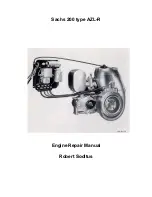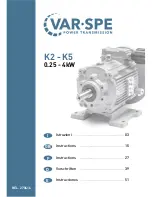
GEN III V8 ENGINE MANAGEMENT
Intermittent Check Powertrain Lamp
In the case of an intermittent problem, the Check Powertrain lamp may light for ten seconds and then will go
out However, the corresponding Diagnostic Trouble Code (DTC) will be stored in the memory of the PCM The
DTC will remain stored in the PCM memory until the Tech 2 erases it When unexpected DTCs appear during
the diagnostic trouble code reading process, one can assume that these DTCs were set by an intermittent
malfunction and could be helpful in diagnosing the system
An intermittent diagnostic trouble code may or may not re-set If it is an intermittent failure, a Diagnostic Trouble
Code Chart is not used Consult the Diagnostic Aids on the page facing the diagnostic chart corresponding to
the intermittent diagnostic trouble code The Symptoms section also covers the topic of intermittents A physical
inspection of the applicable sub-system most often will resolve the problem The Tech 2 also has several
features which can help with diagnosing intermittents, such as the Wiring Harness integrity test
STRATEGY BASED DIAGNOSTICS
The strategy based diagnostic is a uniform approach to repair all Electrical/Electronic systems The diagnostic
flow can always be used to resolve an Electrical/Electronic system problem and is a starting point when repairs
are necessary The steps below are defined to instruct the technician how to proceed with a diagnostic process
Steps below also refer to step numbers found on the Strategy Based Diagnostic table
1 . Verify the Driver Concern: To verify the driver concern, the technician should know the normal operation
of the system
2. Preliminary Check: Conduct a thorough visual and operational inspection, review the service history,
detect unusual sounds or odours, and gather diagnostic trouble code information to achieve effective repair
3. Service information (Manual) System Check(s): System checks verify proper operation of the system
This will lead the technician in an organised approach to diagnostics
4. Check Bulletins and Other Service Information: This should include, Techlines, All Dealer letters, and
Service Training Publications
5. Service Diagnostics (Paper/Electronic)
5.1 DTC Stored: Follow the designed DTC table exactly to make an effective repair
5.2 Symptom, No DTC: Select the symptom from the symptom tables and follow the diagnostic paths or
suggestions to complete the repair, or refer to the applicable component/system checks in Section 6C3-
2C in the Service Manual
5.3 No Published Diagnostics: Analyse the complaint and develop a plan for diagnostics Utilise the wiring
diagrams and theory of operation
Call Technical Assistance for similar cases where repair history may be available Combine technician
knowledge with efficient use of the available service information
5.4 Intermittent faults: Conditions that are not always present are intermittent To resolve intermittents,
perform the following steps
5.4.1 Observe history DTCs, DTC modes and Freeze Frame data
5.4.2 Evaluate the symptoms and conditions described by the driver
5.4.3 Use a check sheet or other method to identify the circuit or electrical system component
5.4.4 Follow the suggestions for intermittent diagnosis found in the service documentation
The Tech 2 and DMM have data capturing capabilities that can assist in detection of intermittents
5.5 Vehicle Operates As Designed/No Trouble Found: This condition exists when the vehicle is found to
be operating normally The condition described by the driver may be normal Verify against another
vehicle that is operating normally The condition may be intermittent Contact Technical Assistance if the
concern is common Verify the complaint under the conditions described by the driver before releasing
the vehicle
6. Re-examine the Concern: When the complaint cannot be successfully found or isolated, a re-evaluation is
necessary The complaint should be re-verified and could be intermittent or normal as per step 5 3 or 5 5
7. Repair and Verification Tests: After isolating the cause, the repair should be made Then validate for
proper operation and verify that the symptom has been corrected This may involve road testing or other
methods to verify the complaint has been resolved under the following conditions
• Conditions noted by the driver
• If a DTC was diagnosed, verify a repair by duplicating conditions present when a DTC was set as noted
in the Freeze Frame/Failure Records data
Page - 8 GEN III V8 ENGINE MANAGEMENT
Summary of Contents for GEN III V8
Page 1: ...HOLDEN GEN III V8 ENGINE MANAGEMENT...
Page 3: ......
Page 4: ...GEN III V8 ENGINE MANAGEMENT CONTENTS SUBJECT GEN III V8 ENGINE MANAGEMENT...
Page 5: ...GEN III V8 ENGINE MANAGEMENT NOTES GEN III V8 ENGINE MANAGEMENT...
Page 7: ...GEN III V8 ENGINE MANAGEMENT Page 2 GEN III V8 ENGINE MANAGEMENT...
Page 8: ...GEN III V8 ENGINE MANAGEMENT Page 3...
Page 14: ...GEN III V8 ENGINE MANAGEMENT GEN III V8 ENGINE MANAGEMENT Page 9...
Page 16: ...GEN III V8 ENGINE MANAGEMENT GEN III V8 ENGINE MANAGEMENT Page 1 1...
Page 20: ...GEN III V8 ENGINE MANAGEMENT GEN III V8 ENGINE MANAGEMENT Page 15...
Page 25: ...GEN III V8 ENGINE MANAGEMENT NOTES Page 20 GEN III V8 ENGINE MANAGEMENT...
Page 29: ...GEN III V8 ENGINE MANAGEMENT Paqe 24 GEN III V8 ENGINE MANAGEMENT...
Page 30: ...GEN III V8 ENGINE MANAGEMENT GEN III V8 ENGINE MANAGEMENT Page 25...
Page 31: ...GEN III V8 ENGINE MANAGEMENT Page 26 GEN III V8 ENGINE MANAGEMENT...
Page 72: ...GEN III V8 ENGINE MANAGEMENT GEN III V8 ENGINE MANAGEMENT Page 67...
Page 85: ...GEN III V8 ENGINE MANAGEMENT Page 80 GEN III V8 ENGINE MANAGEMENT...
Page 90: ...GEN III V8 ENGINE MANAGEMENT GEN III V8 ENGINE MANAGEMENT Page 85...
Page 94: ...GEN III V8 ENGINE MANAGEMENT GEN III V8 ENGINE MANAGEMENT Page 89...
Page 104: ...GEN III V8 ENGINE MANAGEMENT GEN III V8 ENGINE MANAGEMENT Page 99...
Page 113: ...GEN III V8 ENGINE MANAGEMENT NOTES Page 108 GEN III V8 ENGINE MANAGEMENT...














































